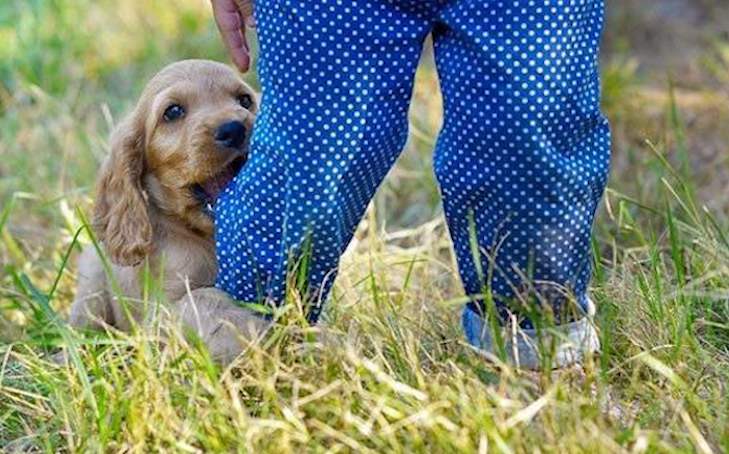
AKC is a participant in affiliate advertising programs designed to provide a means for sites to earn advertising fees by advertising and linking to akc.org. If you purchase a product through this article, we may receive a portion of the sale.
It’s the dog misdeed most likely to turn an owner’s face beet red—humping. When your pup gets that gleam in their eye and mounts their pal (or worse, yours), it’s tempting to yell, pull the dog away by force, or pray for the ground to open and swallow you. But with a little patience, owners of rambunctious, hump-happy dogs can learn to understand why their dog is humping, and how to productively redirect to curb the behavior.
Why Do Dogs Hump?
First, the good news. Humping is a very common behavior. You are far from alone in having a hump-loving dog. And, despite appearances, it’s not necessarily sexually motivated.
“Often, humping has nothing to do with sex,” explains certified applied animal behaviorist Dr. Mary B`urch, director of the Canine Good Citizen (CGC) program.
So what is it all about? Very often, Dr. Burch says, humping is an attempt at dominance. This can apply whether it’s a human or another dog on the receiving end. Sometimes, it’s a sign that the dog is stressed, overstimulated, or acting out.
“When a pillow or stuffed animal are the objects of your dog’s affection, there’s a good chance the dog has simply gotten excited and over-stimulated,” notes Dr. Burch. “Rowdy play can cause some dogs to get out of control.”

Occasionally, humping can be a sign of a medical problem. For instance, humping can signal infection or irritation, or, in male dogs, prostate problems. It is also true that in certain cases, humping is a sexual, pleasure-seeking behavior. The likelihood of humping being sexual in nature is greater in younger dogs that have not been spayed or neutered.
When Is Humping a Problem?
Brief moments of humping between dogs can be a normal part of play. For instance, while running and playing, dogs might take turns mounting each other in a harmless expression of excitement. But some dogs don’t like to be mounted. So in the interest of avoiding any potential conflict, it’s worth doing some work to prevent even this mild form of mounting.
Humping will also be easier to curb if you catch it early, instead of waiting until the behavior is an embedded habit. While you might want to laugh the first time you see your dog hump, in the longer term, it’s best to step in and redirect the behavior immediately.
How Can You Stop Your Dog From Humping?
If your dog is also licking or chewing their own body, or showing other signs of distress, their humping behavior may be indicative of medical issues. If this is the case, make an appointment with your veterinarian.
It’s also important to consider any stressors that might be causing your dog to act out. Are they getting enough exercise and stimulation? Is something in the home aggravating them, and, if so, what can you do to alleviate it?
Once you’ve ruled out a medical or environmental cause, you can turn your attention to behavioral fixes. The path to a hump-free home begins with training. Since humping is often about domination, effective training is important because it establishes your authority, letting your dog know you’re in charge.
This is good for you and good for the dog. It’s calming for them to know that they can trust your authority. Plus, good training will make it easier for them to get along with other dogs and people. Consider signing up for training classes, or, if you want to go a step further, enroll in the CGC program.

If your dog is well-trained but still humping, you can put that training to good use. The best way to treat humping is to redirect. This lets the dog know that the behavior is not wanted, and allows for positive reinforcement if they successfully perform another command.
When the humping starts, ask the dog to sit, lie down, or stay, and reward them when they do. Alternatively, redirect with a game of fetch or by taking the dog outside for some exercise.
Minimize Mounting Opportunities
When your dog is persistently mounting a visitor, and redirecting doesn’t stop the behavior, don’t yell or make a fuss. Simply go to the dog and calmly take them to their crate or another quiet area.
You can also manage your dog’s environment to minimize humping. Make sure they have access to chew toys and other activities that keep them occupied and burn energy. If there’s a particular toy or another object that bears the brunt of your dog’s humping, take it away until the behavior has eased. And if you’re expecting a visitor who is someone you do not want your dog to mount under any circumstances, simply put your pup out of the way while that person is around.
Finally, if your dog is not spayed or neutered, consider discussing this option with your vet. While some experts recommend sterilization as a way to curb sexually motivated mounting, bear in mind that recent research indicates that spaying and neutering certain breeds at young ages can have long-term health implications. If your dog is still very young, you may want to continue to manage the behavior through training until they’ve reached a safe age for alteration.

